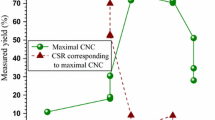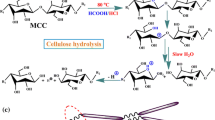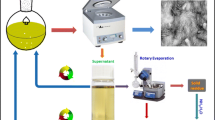Abstract
From a green chemistry perspective, cryogrinding of cellulose fibers conducted under mild conditions is introduced as a rapid, facile, and scalable methodology for the mechanochemical synthesis of cellulose nanocrystals. Traditionally, they are synthesized in a solution using acid/oxidation-based methods in a multi-stage process. This work presents a method for the production of hairy carboxylated nanocrystalline cellulose (HNC) through a mechanochemical process from wood kraft pulp, using two different procedures: (1) dry-cryogrinding (HNC-1 and HNC-2), and (2) cryogrinding with mono-chloroacetate (MCA) under alkaline conditions (HNC-10 and HNC-40). Solid carbon-13 NMR and FTIR spectroscopy proved the presence of carboxyl groups on the nanoparticles. XRD shows that HNC-1 and HNC-2 corresponded to the type I allomorph of cellulose while HNC-10 and HNC-40 corresponded to cellulose II. The crystallinity of nanocelluloses decreases with increasing milling time. HNC nanoparticles produced by cryogrinding are electrosterically stable due to the presence of both protruding chains (“hairs”) and anionic charges, as confirmed by DLS. All HNC particles produced by cryogrinding are rod-shaped with a similar diameter, but HNC-1 and HNC-2 particles are about three times longer than HNC-10 and HNC-40. The unique molecular and crystal structure of the produced HNCs may be important for subsequent chemical modification and developing new applications.









Similar content being viewed by others
References
Adrjanowicz K, Kaminski K, Grzybowska K, Hawelek L, Paluch M, Gruszka I, Zakowiecki D, Sawicki W, Lepek P, Kamysz W, Guzik L (2011) Effect of cryogrinding on chemical stability of the sparingly water-soluble drug furosemide. Pharm Res 28:3220–3236
Araki J, Kuga S (2001) Effect of trace electrolyte on liquid crystal type of cellulose microcrystals. Langmuir 17:4493–4496
Bardet M, Foray MF, Trân QK (2002) High-resolution solid-state CPMAS NMR study of archaeological woods. Anal Chem 74:4386–4390
Baytekin HT, Baytekin B, Incorvati JT, Grzybowski BA (2012) Material transfer and polarity reversal in contact charging. Angew Chem Int Ed 51:4843–4847
Bhandari PN, Jones D, Hanna MA (2012) Carboxymethylation of cellulose using reactive extrusion. Carbohydr Polym 87:2246–2254
Boukhoubza I, Khenfouch M, Achehboune M, Mothudi BM, Zorkani I, Jorio A (2019) X-ray diffraction investigations of nanostructured ZnO coated with reduced graphene oxide. J Phys Conf Ser 1292:012011
Chang ST, Chang HT (2001) Comparisons of the photostability of esterified wood. Polym Degrad Stab 71:261–266
Cheng M, Qin Z, Liu Y, Qin Y, Li T, Chen L, Zhu M (2014) Efficient extraction of carboxylated spherical cellulose nanocrystals with narrow distribution through hydrolysis of lyocell fibers by using ammonium persulfate as an oxidant. J Mater Chem A2:251–258
Cheng D, Wei P, Zhang L, Cai J (2019) New approach for the fabrication of carboxymethyl cellulose nanofibrils and the reinforcement effect in water-borne polyurethane. ACS Sustain Chem Eng 7:11850–11860
de Souza Coelho CC, Silva RBS, Carvalho CWP, Rossi AL, Teixeira JA, Freitas-Silva O, Cabral LMC (2020) Cellulose nanocrystals from grape pomace and their use for the development of starch-based nanocomposite films. Int J Bio Macromol 159:1048–1061
Dias ARG, da Rosa ZE, Helbig E, de Moura FA, Vargas CG, Ciacco CF (2011) Oxidation of fermented cassava starch using hydrogen peroxide. Carbohydr Polym 86:185–191
Du L, Wang J, Zhang Y, Qi C, Wolcott MP, Yu Z (2017) A co-production of sugars, lignosulfonates, cellulose, and cellulose nanocrystals from ball-milled woods. Bioresour Technol 238:254–262
El Oudiani A, Chaabouni Y, Msahli S, Sakli F (2011) Crystal transition from cellulose I to cellulose II in NaOH treated Agave americana L. fibre. Carbohyd Polym 86:1221–1229
El-Wakil NA, Hassan M (2008) Structural changes of regenerated cellulose dissolved in FeTNa, NaOH/thiourea, and NMMO systems. J Appl Polym Sci 109:2862–2871
Fiss BG, Hatherly L, Stein RS, Friscic T, Moores A (2019) Mechanochemical phosphorylation of polymers and synthesis of flame-retardant cellulose nanocrystals. ACS Sustain Chem Eng 7:7951–7959
French AD (2014) Idealized powder diffraction patterns for cellulose polymorphs. Cellulose 21:885–896
French AD, Santiago Cintrón M (2013) Cellulose polymorphy, crystallite size, and the Segal crystallinity Index. Cellulose 20:583–588
Golmohammadi H, Morales-Narvaez E, Naghdi T, Merkoci A (2017) Nanocellulose in sensing and biosensing. Chem Mater 29:5426–5446
Gong J, Li J, Xu J, Xiang Z, Mo L (2017) Research on cellulose nanocrystals produced from cellulose sources with various polymorphs. RSC Adv 7:33486–33493
Goussé C, Chanzy H, Excoffier G, Soubeyrand L, Fleury E (2002) Stable suspensions of partially silylated cellulose whiskers dispersed in organic solvents. Polymer 43:2645–2651
Habibi Y, Lucia LA, Rojas OJ (2010) Cellulose nanocrystals: chemistry, self-assembly, and applications. Chem Rev 110:3479–3500
Halib N, Perrone F, Cemazar M, Dapas B, Farra R, Abrami M, Chiarappa G, Forte G, Zanconati F, Pozzato G, Murena L (2017) Potential applications of nanocellulose-containing materials in the biomedical field. Materials 10(8):977
Isogai A, Usuda M, Kato T, Ury T, Atalla RH (1989) Solid-state CP/MAS carbon-13 NMR study of cellulose polymorphs. Macromolecules 22:3168–3172
Kamphunthong W, Hornsby P, Sirisinha K (2012) Isolation of cellulose nanofibers from para rubberwood and their reinforcing effect in poly(vinyl alcohol) composites. J Appl Polym Sci 125:1642–1651
Kang X, Kuga S, Wang C, Zhao Y, Wu M, Huang Y (2018) Green preparation of cellulose nanocrystal and its application. ACS Sustain Chem Eng 6:2954–2960
Keshk SMAS, Yahia IS (2018) Physicochemical characterization of different cellulose polymorphs/graphene oxide composites and their antibacterial activity. Turk J Chem 42:562–571
Kim JH, Lee D, Lee YH, Chen W, Lee SY (2019) Nanocellulose for energy storage systems: beyond the limits of synthetic materials. Adv Mater 31:1804826
Kleine T, Buendia J, Bolm C (2013) Mechanochemical degradation of lignin and wood by solvent-free grinding in a reactive medium. Green Chem 15:160–166
Koshani R, van de Ven TGM (2020a) Electroacoustic characterization of trimmed hairy nanocelluloses. J Colloid Interface Sci 563:252–260
Koshani R, van de Ven TGM (2020b) Carboxylated cellulose nanocrystals developed by Cu-assisted H2O2 oxidation as green nanocarriers for efficient lysozyme immobilization. J Agric Food Chem 68:5938–5950
Koshani R, van de Ven TGM, Madadlou A (2018) Characterization of carboxylated cellulose nanocrytals isolated through catalyst-assisted H2O2 oxidation in a one-step procedure. J Agric Food Chem 66:7692–7700
Kwiczak-Yiğitbaşı J, Laçin Ö, Demir M, Ahan RE, Şeker UÖŞ, Baytekin B (2020) A sustainable preparation of catalytically active and antibacterial cellulose metal nanocomposites via ball milling of cellulose. Green Chem 22:455–464
Labib ME, Robertson AA (1980) The conductometric titration of latices. J Colloid Interface Sci 77:151–161
Lacin O, Kwiczak-Yigitbaşı J, Erkan M, Cevher SC, Baytekin B (2019) The morphological changes upon cryomilling of cellulose and concurrent generation of mechanoradicals. Polym Degrad Stab 168:108945
Li Q, Renneckar S (2011) Supramolecular structure characterization of molecularly thin cellulose I nanoparticles. Biomacromol 12:650–659
Li MC, Wu Q, Song K, Qing Y, Wu Y (2015) Cellulose nanoparticles as modifiers for rheology and fluid loss in bentonite water-based fluids. ACS Appl Mater Interfaces 7:5006–5016
Liimatainen H, Visanko M, Sirviö JA, Hormi OE, Niinimaki J (2012) Enhancement of the nanofibrillation of wood cellulose through sequential periodate–chlorite oxidation. Biomacromol 13:1592–1597
Ling Z, Wang T, Makarem M, Santiago Cintrón M, Cheng HN, Kang X, Bacher M, Potthast A, Rosenau T, King H, Delhom CD (2019) Effects of ball milling on the structure of cotton cellulose. Cellulose 26:305–328
Lu QL, Li XY, Tang LR, Lu BL, Huang B (2015) One-pot tandem reactions for the preparation of esterified cellulose nanocrystals with 4-dimethylaminopyridine as a catalyst. RSC Adv 5:56198–56204
Lu Q, Lu L, Li Y, Huang B (2019) Facile manufacture of cellulose nanoparticles in high yields by efficient cleavage of hydrogen bonds via mechanochemical synergy. Cellulose 26:7741–7751
Luo W, Abbas ME, Zhu L, Deng K, Tang H (2008) Rapid quantitative determination of hydrogen peroxide by oxidation decolorization of methyl orange using a Fenton reaction system. Anal Chim Acta 629:1–5
Mondal Md. IH, Yaesmin S, Rahman Md. S (2015) Preparation of food grade carboxymethyl cellulose from corn husk agrowaste. Int J biol macromol 79:144–150
Morán JI, Alvarez VA, Cyras VP, Vázquez A (2008) Extraction of cellulose and preparation of nanocellulose from sisal fibers. Cellulose 15:149–159
Nam S, French AD, Condon BD, Concha M (2016) Segal crystallinity index revisited by the simulation of X-ray diffraction patterns of cotton cellulose Iβ and cellulose II. Carbohyd Polym 135:1–9
Neto WPF, Putaux JL, Mariano M, Ogawa Y, Otaguro H, Pasquini D, Dufresne A (2016) Comprehensive morphological and structural investigation of cellulose I and II nanocrystals prepared by sulphuric acid hydrolysis. RSC Adv 6:76017–76027
Nge TT, Lee SH, Endo T (2013) Preparation of nanoscale cellulose materials with different morphologies by mechanical treatments and their characterization. Cellulose 20:1841–1852
Nishiyama Y (2018) Molecular interactions in nanocellulose assembly. Philos Trans R Soc A 376:20170047
Nuruddin M, Hosur M, Uddin MJ, Baah D, Jeelani S (2016) A novel approach for extracting cellulose nanofibers from lignocellulosic biomass by ball milling combined with chemical treatment. J Appl Polym Sci. https://doi.org/10.1002/app.42990
Oh SY, Yoo DI, Shin Y, Kim HC, Kim HY, Chung YS, Park WH, Youk JH (2005) Crystalline structure analysis of cellulose treated with sodium hydroxide and carbon dioxide by means of X-ray diffraction and FTIR spectroscopy. Carbohydr Res 340:2376–2391
Ohura T, Tsutaki Y, Sakaguchi M (2014) Novel synthesis of cellulose-based diblock copolymer of poly (hydroxyethyl methacrylate) by mechanochemical reaction. Sci World J 2014:1–4
Pas T, Smeets B, Ramon H, Van Schepdael A, Mansour M, Koekoekx R, Clasen C, Vergauwen B, Van den Mooter G (2020) Mechanodegradation of polymers: a limiting factor of mechanochemical activation in the production of amorphous solid dispersions by cryomilling. Mol Pharm 17:2987–2999
Rafieian F, Shahedi M, Keramat J, Simonsen J (2014) Mechanical, thermal and barrier properties of nano-biocomposite based on gluten and carboxylated cellulose nanocrystals. Ind Crops Prod 53:282–288
Safari S, van de Ven TGM (2016) Effect of water vapor adsorption on electrical properties of carbon nanotube/nanocrystalline cellulose composites. ACS Appl Mater Interfaces 8:9483–9489
Saito T, Kimura S, Nishiyama Y, Isogai A (2007) Cellulose nanofibers prepared by TEMPO-mediated oxidation of native cellulose. Biomacromol 8:2485–2491
Sakaguchi M, Ohura T, Iwata T, Enomoto-Rogers Y (2012) Nanocellulose particles covered with block copolymer of cellulose and methyl methacrylate produced by solid mechano chemical polymerization. Polym Degrad Stab 97:257–263
Salam A, Lucia LA, Jameel H (2013) A novel cellulose nanocrystals-based approach to improve the mechanical properties of recycled paper. ACS Sustain Chem Eng 1:1584–1592
Scherrer P (1918) Determination of the size and internal structure of colloidal particles using X-rays. Nachr Ges Wiss Göttingen 2:98–100
Segal LGJMA, Creely JJ, Martin AE Jr, Conrad CM (1959) An empirical method for estimating the degree of crystallinity of native cellulose using the X-ray diffractometer. Text Res J 29:786–794
Seta FT, An X, Liu L, Zhang H, Yang J, Zhang W, Nie S, Yao S, Cao H, Xu Q, Bu Y (2020) Preparation and characterization of high yield cellulose nanocrystals (CNC) derived from ball mill pretreatment and maleic acid hydrolysis. Carbohydr Polym 234:115942
Sheikhi A, Li N, van de Ven TGM, Kakkar A (2016) Macromolecule-based platforms for developing tailor-made formulations for scale inhibition Environ. Sci Water Res Technol 2:71–84
Sheikhi A, Safari S, Yang H, van de Ven TGM (2015) Copper removal using electrosterically stabilized nanocrystalline cellulose. ACS Appl Mater Interfaces 7:11301–11308
Siqueira G, Bras J, Dufresne A (2010) Cellulosic bionanocomposites: a review of preparation, properties and applications. Polymers 2(4):728–765
Solala I, Volperts A, Andersone A, Dizhbite T, Mironova-Ulmane N, Vehniäinen A, Pere J, Vuorinen T (2012) Mechanoradical formation and its effects on birch kraft pulp during the preparation of nanofibrillated cellulose with Masuko refining. Holzforschung 66:477–483
Song K, Ji Y, Wang L, Wei Y, Yu Z (2018) A green and environmental benign method to extract cellulose nanocrystal by ball mill assisted solid acid hydrolysis. J Clean Prod 196:1169–1175
Tang L, Huang B, Yang N, Li T, Lu Q, Lin W, Chen X (2013) Organic solvent-free and efficient manufacture of functionalized cellulose nanocrystals via one-pot tandem reactions. Green Chem 15:2369–2373
Tang Y, Shen X, Zhang J, Guo D, Kong F, Zhang N (2015) Extraction of cellulose nano-crystals from old corrugated container fiber using phosphoric acid and enzymatic hydrolysis followed by sonication. Carbohydr Polym 125:360–366
Tanvir A, Al-Maadeed MA, Hassan MK (2017) Secondary chain motion and mechanical properties of γ-irradiated-regenerated cellulose films. Starch-Stärke 69:1500329
Tavakolian M, Lerner J, Tovar FM, Frances J, van de Ven TGM, Kakkar A (2019b) Dendrimer directed assembly of dicarboxylated hairy nanocellulose. J Colloid Interface Sci 541:444–453
Tavakolian M, Okshevsky M, van de Ven TGM, Tufenkji N (2018) Developing antibacterial nanocrystalline cellulose using natural antibacterial agents. ACS Appl Mater Interfaces 10:33827–33838
Tavakolian M, Wiebe H, Sadeghi MA, van de Ven TGM (2019a) Dye removal using hairy nanocellulose: experimental and theoretical investigations. ACS Appl Mater Interfaces 12:5040–5049
van de Ven TGM, Sheikhi A (2016) Hairy cellulose nanocrystalloids: a novel class of nanocellulose. Nanoscale 8:15101–15114
Wang H (1994) Step size, scanning speed and shape of X-ray diffraction peak. J Appl Crystallography 27:716–722
Wang Y, Chen L (2014) Cellulose nanowhiskers and fiber alignment greatly improve mechanical properties of electrospun prolamin protein fibers. ACS Appl Mater Interfaces 6:1709–1718
Wei H, Rodriguez K, Renneckar S, Vikesland PJ (2014) Environmental science and engineering applications of nanocellulose-based nanocomposites. Environ Sci Nano 1:302–316
Widiyastuti W, Balgis R, Setyawan H (2019) Production of cellulose aerogels from coir fibers via an alkali–urea method for sorption applications. Cellulose 26:9583–9598
Xie H, Du H, Yang X, Si C (2018) Recent strategies in preparation of cellulose nanocrystals and cellulose nanofibrils derived from raw cellulose materials. Int J Polym Sci 2018:1–25
Yan FY, Krishniah D, Rajin M, Bono A (2009) Cellulose extraction from palm kernel cake using liquid phase oxidation. J Eng Sci Technol 4:57–68
Yang H, Alam MdN, van de Ven TGM (2013b) Highly charged nanocrystalline cellulose and dicarboxylated cellulose from periodate and chlorite oxidized cellulose fibers. Cellulose 20:1865–1875
Yang Q, Fujisawa S, Saito T, Isogai A (2012) Improvement of mechanical and oxygen barrier properties of cellulose films by controlling drying conditions of regenerated cellulose hydrogels. Cellulose 19:695–703
Yang D, Peng XW, Zhong LX, Cao XF, Chen W, Sun RC (2013a) Effects of pretreatments on crystalline properties and morphology of cellulose nanocrystals. Cellulose 20:2427–2437
Yang Q, Saito T, Berglund LA, Isogai A (2015) Cellulose nanofibrils improve the properties of all-cellulose composites by the nano-reinforcement mechanism and nanofibril-induced crystallization. Nanoscale 42:17957–17963
Ye J, Schoenung JM (2004) Technical cost modeling for the mechanical milling at cryogenic temperature (cryomilling). Adv Eng Mater 6:656–664
Youssefian S (2019) Conformational transformation of pH-responsive hairy cellulose nanocrystalloids in salt-free dilute solutions. Biomacromol 20:2839–2851
Yu H, Sun B, Zhang D, Chen G, Yang X, Yao J (2014) Reinforcement of biodegradable poly (3-hydroxybutyrate-co-3-hydroxyvalerate) with cellulose nanocrystal/silver nanohybrids as bifunctional nanofillers. J Mater Chem B 2:8479–8489
Yu HY, Zhang DZ, Lu FF, Yao J (2016) New approach for single-step extraction of carboxylated cellulose nanocrystals for their use as adsorbents and flocculants. ACS Sustain Chem Eng 4:2632–2643
Zhang J, Li D, Zhang X, Shi Y (1993) Solvent effect on carboxymethylation of cellulose. J Appl Polym Sci 49:741–746
Acknowledgments
The authors like to thank the Natural Sciences and Engineering Research Council of Canada, (NSERC-discovery Grant 2018-05781) for the financial support of this project.
Author information
Authors and Affiliations
Corresponding author
Additional information
Publisher's Note
Springer Nature remains neutral with regard to jurisdictional claims in published maps and institutional affiliations.
Supplementary Information
Below is the link to the electronic supplementary material.
Rights and permissions
About this article
Cite this article
Mahrous, F., Koshani, R., Tavakolian, M. et al. Formation of hairy cellulose nanocrystals by cryogrinding. Cellulose 28, 8387–8403 (2021). https://doi.org/10.1007/s10570-021-04092-2
Received:
Accepted:
Published:
Issue Date:
DOI: https://doi.org/10.1007/s10570-021-04092-2




